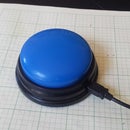Introduction: Fog Trident
For Halloween a few years back I made a Devil's Trident with a portable fog machine built inside. It was a fun toy but a dangerous as a party trick (hot steam and exhaust, fragile butane feed system near fire). I don't have many work-in-process pictures but I'll try to describe as best I can.
Fog machines work by passing fog solution (propylene glycol and water) through a heat exchanger above its boiling point under pressure and out a very fine nozzle. In a commercial fog machine, the exchanger block is electrically heated and the fog solution is pumped in via a small electric pump. In my case, I wanted a highly portable and purely mechanical solution.
Feed System: Fog solution is stored in a section of bicycle tire at the back of the staff. A small valve at the front of the tire controls the flow of solution into the heat exchanger The tire is inside a sealed chamber of PVC with a schrader valve (stolen from the same tire) on one end. By pressurizing the PVC chamber through the shrader valve, you put the fog solution under pressure but keep it separate from the air.
Heat Exchanger: The heat exchanger consists of an outer steel shell and inner aluminum body. The aluminum body is a cylinder with fins on the outside and a hole down the axis. The torch flame passes down the inside of the cylinder while the fog solution circulates across the fins towards the nozzle at the end. The exchanger body is press fit into an outer steel shell that has the small nozzle drilled into it. The shell also has an extended exhaust section for dissipating waste heat safely (sort of).
Torch: The system is heated using a small butane torch modified from a commercial torch purchased at Home Depot. The torch head is epoxied into the heat exchanger. The butane tank sits behind an aluminum barrier. The original piezoelectric igniter sticks out of the staff and a small (finicky) lever controls the flow of gas.
To run the torch:
- Fill the tire through the feed valve and assemble the staff.
- Pressurize the solution chamber.
- Turn on the flow of gas and immediately spark the ignitor.
- Wait a minute for the exchanger to heat up
- Open the solution valve slightly to start the fog!
Overall, this was an exciting project and a successful first prototype. It was however quite fragile and dangerous. If you attempt a similar project, there are a few things you should pay close attention to:
- Dissipating exhaust heat safely was a big challenge
- The nozzle needs to be extremely small to atomize the solution properly and avoid spraying scalding droplets
- The system builds up quite a bit of pressure -- make sure your joints won't leak
- Regulating temperature, flow rate and pressure more precisely would have produced better results
- I suspect my heat exchanger design resulted in hot spots near the intake port and cold spots near the nozzle -- I suggest designing for the opposite result.













